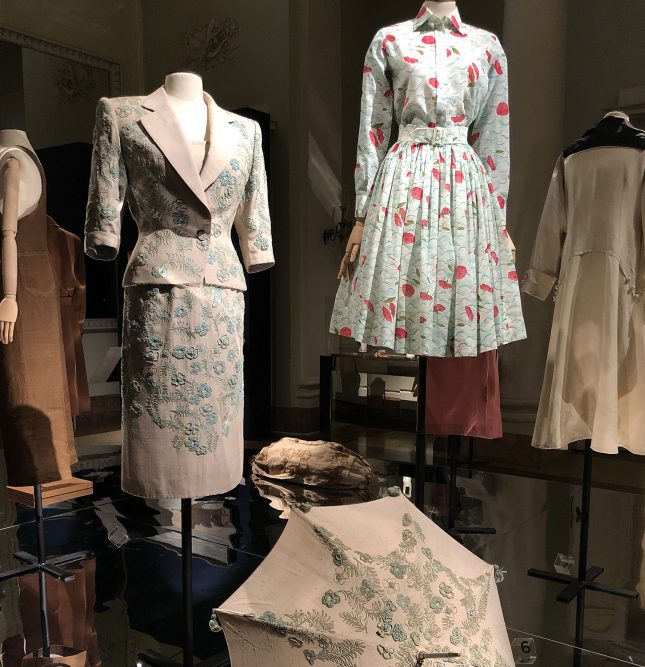Frame-worthy Fashion at Palazzo Pitti

TRACCE 2018. Costume Gallery, Pitti Palace. Pitti Palace open Tuesday – Sunday 8:15 am-6:15 pm. Admission € 16, reduced € 8.
While it’s true that Italy is home to contemporary fashion power houses such as Gucci, Valentino and Dolce & Gabbana, the country’s past possesses an equally rich sartorial history. Explore archival materials of both Italian and European fashion designers such as Roberto Capucci and Azzedine Alaïa at Palazzo Pitti’s new fashion exhibition, entitled Traces 2018.
Curated by Caterina Chiarelli, Simonella Condemi and Tommaso Lagattolla, Traces 2018 tracks the relationship between art and fashion of the 20th century. The exhibition is a continuation of Traces 2017, which opened last winter. Inaugurated on July 16 and located in Palazzo Pitti’s Galleria del Costume, the new segment of Traces exhibits lavish designs within palatial 16th century rooms. The palace is the perfect location for a fashion exhibition: its Sala Bianca was the choice location for premiere designers of the 1950s to showcase their new collections. Just recently, Gucci hosted its 2018 Resort collection at Palazzo Pitti in 2017. Organized by theme rather than time period, each of the 15 rooms in the exhibition is a sumptuous pocket of fashion and art objects.
In the first room, entitled Colors of Nature – Flowers, a 1913 portrait of Rudolfo Peruzzi de’ Medici hangs behind two brocade scarlet evening coats designed by Gianfranco Ferré and an aubergine Jole Veneziani cocktail dress and stole. Though Traces’ first room is all rich reds and purples, the following room’s palette is soft, a symphony of white, cream, robin’s egg blue, gold and silver. The room, entitled Lyrical Presence, features Roberto Capucci’s 1986 angelic opera costume made for a production of Bellini’s Norma, offset by Giulio Bargellini’s ethereal 1899 painting Eternal Idiom.
The next room: Wearing Relief, displays three of Gianfranco Ferré’s designs: black shifts with gilded embellishment and a red mock-neck gown with epaulette-like trimmings at the waist. The following room, whose walls are covered with kelly-green damask, is devoted to the work of Roberto Capucci. In Sharing Contrast, a slinky bias-cut black dress, lavish bicolor evening gown, and peasant-sleeve cocktail dress stand before a dark abstract painting entitled Laceration by the Florentine painter Nativi. The next rooms: Pure Volumes and Pure Lines contain all black dresses and all turquoise dresses respectively. The highlights in these rooms are a velvet late-eighties Azzedine Alaïa dress and an all-over beaded Roberto Capucci shift.
Curated in conjunction with the Pitti Palace’s exhibition The Elegance of Speed, the main section of the exhibition: Fashionable Pathways, hosts an array of fashion accessories, travel cases, clothing, and artwork. Under the glittering chandelier of the Costume Galleries’ main room are three wide-lapeled driving coats in shades of rose, cream and black. Among the garments in this room is a Pucci floral-printed blouse and skirt set, a linen skirt-suit and a matching umbrella embroidered with aqua and green flowering vines, canvas dungarees and a Prince-of-Wales-check dress-coat. Toy tin cars sit in cases beside silk scarves, Gucci loafers, a Givenchy turbanette and wire travel hangers. An Anthony DeWitt painting rendered in moody greys, teals and purples hangs above Giovanni Michelucci’s 1926 abstract sculpture Model of the Church of the Autostrada del Sole. It is in this room that the exhibition’s aim: to present garments alongside art and accessories in a harmonious story, is the most successful.
In the following room: Different, multicolored sequin dresses are displayed across from a case of vintage denim and two oil paintings from the collection. The next section, Experimenting, displays three of Roberto Cavalli’s leather-appliqued designs from the seventies and eighties. A painting of a parrot hangs behind the one of the Cavalli dresses designed with a suede appliqué parrot on the side. In this section, the garments’ connection to the painting seems superficial, too obvious, though the clothes’ workmanship is impressive, their shared narrative cohesive.
The next room, Prototype traces the origins of the suit, outlining the legacy of Coco Chanel. Glittering Chanel jewelry designed by Leo France lays in a case in front of a statuesque sculpture by Quinto Martini. 4 blush pink and cream tweed Chanel suits are opposite a little tailored black Dior jacket. The room covers both poles of the suit: the reserved and the luxurious.
The room devoted to the dressmaker Alma Mari Lami, entitled When Form Becomes Style, displays the most beautiful garments in the exhibition. Designs from the 1950s: a crimson sequined strapless frock, a pearl-trimmed dress with a pleated skirt, and an Edwardian-inspired embroidered ivory gown are aligned in a row across from a vibrantly colored Felice Casorati painting The Foreigner.
Colours in Motion displays more of Gianfranco Ferré’s designs. Alongside the gold lace, knit stripes, and plaid taffeta frocks is a Plexiglas sandal threaded through with delicate wires, a sculpture entitled Flight from the Uffizi. The connection between Flight from the Uffizi and the designs is unclear, though this is the first room in which the art proves less a backdrop for the clothes and more stand alone pieces. On the side wall is a textured color-blocked work painted in a color scheme similar to the dresses’.
The room entitled Uniquely Mass Produced features three sportily-cut Azzedine Alaïa dresses before a graphic silk screen print by Giuseppe Capogrossi. The final room is dedicated to formalwear of both men and women. On one side of the room are colorful Ozwald Boateng ties in shades of magenta, yellow and turquoise and well-pressed men’s suits. Facing the men’s section is a princess-seamed ombré magenta evening gown rendered in lustrous silk-satin and three black dresses whose designs recall that of men’s suiting.
A beautiful exhibit spanning a range of time periods and exhibiting the same wide-range of accessories, art and garments, Traces 2018 impresses. (isabelle blank)
